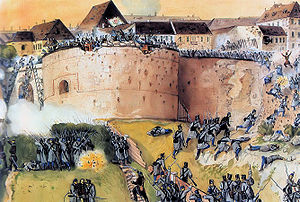Siege of Buda (1849)
| Siege of Buda | |||||||
|---|---|---|---|---|---|---|---|
| Part of the Hungarian Revolution of 1848 | |||||||
 Painting by Mór Than |
|||||||
|
|||||||
| Belligerents | |||||||
|
|
|
||||||
| Commanders and leaders | |||||||
|
|
|
||||||
| Strength | |||||||
|
Total: 34,277 men - I. corps: 9465 - II. corps: 7799 -III. corps: 9419 -VII. corps, 15. division: 4883 - 12. division: 2711 142 cannons |
4,890 men 85 cannons |
||||||
| Casualties and losses | |||||||
| 368/427 dead 700/691 injured |
710 dead 4,204 captured 248 cannons |
||||||
The Siege of Buda (Hungarian: Buda ostroma) was the siege of the Buda castle, part of the twin capital cities of the Kingdom of Hungary by the Hungarian revolutionary army led by General Artúr Görgei, during the Hungarian War of Independence. It was part of the Spring Campaign, fought between 4 and 21 May 1849 and ended with the Hungarian capture of the castle by assault on 21 May. Actually it was the only fortress in the 1848-1849 Hungarian Freedom War, which was taken by the assault of the besieging troops of any of the fighting parts, the others being taken only after agreements between the besiegers and the besieged, with the capitulation of the latters, the capture of Buda on 21 May 1849 by assault being the only exception from this. The siege of Buda was also the shortest siege in the Hungarian Freedom War of 1848-1849 (18 days). The senseless bombardment of Pest by Major General Heinrich Hentzi, the Austrian commander of the city of Pest destroyed the classicist buildings from the shores of the Danube, but the other parts of the capitals also suffered heavy damages because of the artillery duels of the two parts. With the capture of the Buda Castle ended the complete liberation of the Hungarian capital cities (Buda and Pest), and thanks to this the second Hungarian revolutionary Government led by Bertalan Szemere together with Lajos Kossuth, the Governor-President of Hungary returned from Debrecen the interim capital of the Hungarian revolution, in the real capital of Hungary. At 21 May 1849, the same day with the capture of Buda, the two emperors: Franz Joseph I of Austria and tsar Nicholas I of Russia signed the final treaty which decided the involvement of 200 000 Russian soldiers (and a 80 000 strong reserve force, in the case that they were needed) in Hungary, in order to help the Habsburg Empire to crush the Hungarian revolution.
...
Wikipedia
